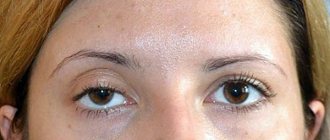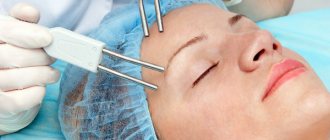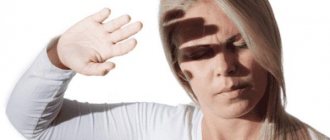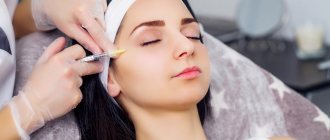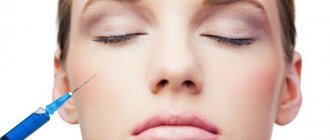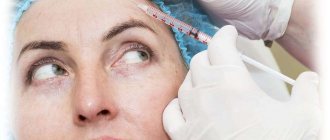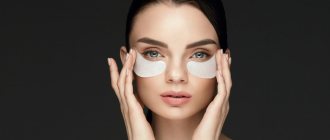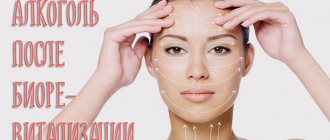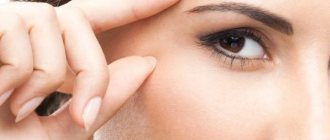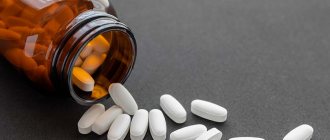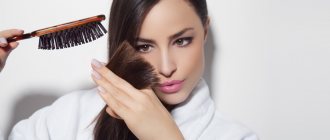The first wrinkles, increased facial asymmetry, a gloomy, tired expression on the face - these are all solvable problems for aesthetic medicine. There is no need to agree to plastic surgery while going through a painful recovery period. Beauty injections take no more than half an hour, and the results can be enjoyed for up to six months. But there are factors that weaken the effect of drugs, reducing the effect of the procedure. Is it possible to combine Botox and antibiotics, and how will this affect the final result?
Why is there a ban?
Cosmetologists warn their clients that Botox and antibiotics are not compatible. But doctors do not always explain why there is a ban, so some people think that the contraindication is unfounded.
Botox is a drug based on botulinum toxin type A. The drug belongs to the group of muscle relaxants, that is, it relaxes the muscles because it blocks its connection with the nervous system. The drug is injected into the muscle, which must be temporarily paralyzed in order to get rid of facial wrinkles.
Antibiotics are antibacterial drugs that either inhibit the activity of pathogens or kill them. They are used when the immune system is not able to cope with the disease on its own.
Weakened immunity is one of the contraindications to botulinum therapy. Botox is a toxin, poison, albeit in small dosages. Only a healthy person whose immune system works like a clock can cope with it without consequences.
Some antibiotics negatively affect kidney function. Namely, it is through them that Botox is removed from the body. It is believed that it stops working when the muscles return to activity, that is, 4-6 months after the procedure. But the drug itself is excreted by the kidneys earlier - 2-3 weeks after the session. A person observes only the residual effect of the drug.
In this regard, antibiotics can enhance the effect of the toxin. Even if the doctor has selected the correct dosage, complications may arise. They affect appearance and health, so you will have to spend a lot of time and money to eliminate the consequences.
Some antibiotics, on the contrary, weaken the effect of the neurotoxin. Even by the end of the second week after the session, when the result should appear, it is not there. There are no complications, but it turns out that the money was wasted.
Compatibility of treatment and procedure
At the initial appointment with a cosmetologist, the client will be asked whether he is taking antibacterial drugs and, if such therapy has been carried out recently, how much time has passed since the last medication. And this is connected with very important points:
Antibacterial drugs for treatment are selected by the doctor. They have an anti-inflammatory effect, and the rules for safe biorevitalization indicate that any pathological process is a contraindication to the anti-aging procedure.
Antibiotics are prescribed by a doctor according to indications. Before performing biorevitalization, you must inform your doctor about the reasons for antibiotic therapy
Antibiotics - a term created on the basis of the word "anti" - is translated as "against", so it can be argued that such drugs kill absolutely all living microorganisms. Biorevitalization, on the contrary, means revitalization of the body, its rejuvenation.
And if antibacterial therapy was carried out for a long time, and at the same time a cosmetic procedure was carried out, then the results may either be completely absent or be completely different from what the client expects. In this case, we are talking about rejection of the introduced cocktails.
- The goals of the procedures are completely different - antibiotic treatment is necessary for health, injections with hyaluronic acid are for beauty. You will have to choose what is needed first. It is impossible to solve two problems at the same time; one of them will remain in any case.
- Each of the drugs individually can cause an allergic reaction. If they enter the body at the same time, then this probability increases significantly. Yes, cocktails for biorevitalization are positioned as hypoallergenic, but they contain not only safe hyaluronic acid, but also vitamins, plant extracts, and minerals.
In addition, after both procedures the body needs some time to restore normal functioning. Rehabilitation after a course of antibacterial therapy involves:
- restoration of intestinal microflora with the help of specific medications, as well as pro/prebiotics;
- the gradual introduction of familiar food products into the menu, the removal of restrictions on spicy dishes, marinades and smoked meats;
- strengthening the immune system by taking vitamin and mineral complexes.
The recovery period after biorevitalization implies some restrictions - for example, any thermal procedures, physical education, and massages are prohibited. It turns out that in the case of any of the procedures, the body’s immune system suffers and if they are carried out simultaneously, the blow may be too powerful.
Doctors categorically do not recommend performing biorevitalization simultaneously with taking antibacterial drugs. It is much more reasonable to wait until the end of the main therapy, wait for the recovery period and only after that visit a cosmetologist about skin rejuvenation.
Possible consequences
If antibiotics weaken the effect of beauty injections, there will be no tragedy. At most, disappointment due to wasted funds. But if the result is the opposite, that is, the medications enhance the effect of the toxin, then the following complications are possible:
- Asymmetry of facial features. Botox concentrates in specific areas without migrating into adjacent tissues, causing the expression to appear unnatural. One side of the face appears drawn.
- Sagging (ptosis) of tissues. Due to the strong migration of the drug, some areas of the face droop. Most often, the eyelids suffer from this - the eye closes by a third, half or completely.
- Problems with speech, swallowing, salivation. They occur when antibiotics cause Botox to migrate mostly to the area around the mouth.
- Visual impairment, diplopia, lacrimation. They arise due to the concentration of the drug in the area around the eyes, penetration through the ocular membrane.
- Violation of facial expressions, temporary paralysis. If Botox is not removed from the body, it acts more aggressively on the muscles.
- Dryness of the mucous membranes of the eyes. Due to paralysis, the frequency of blinking decreases. The eyeballs are less likely to be moistened and remain almost without protection. In addition to unpleasant sensations, this threatens conjunctivitis and other diseases.
❤
What is the impact?
Combining antibiotics and Botox can affect both the procedure itself and the woman’s health in general.
Different groups of antibacterial drugs can cause different manifestations.
On human health
Antibacterial and botulinum agents initiate similar effects .
By reducing neuromuscular conduction, antibiotics lead to relaxation of the facial muscles and neck muscles, which leads to the partial or complete disappearance of the hated folds. If Botox is also administered at this moment, a complete blockade of the innervation of the muscle fiber will occur. Due to the excessive effect, the patient may face unpleasant serious consequences, such as an amicable facial expression and its asymmetry, impaired articulation, ptosis (fixed upper eyelid), and a decrease in the frequency of blinking. In rare cases, impaired concentration and double vision and complete paralysis of the eye muscles may occur.
For the result
Another equally pleasant situation is possible. Under the influence of the chemical, the muscles will relax, and the cosmetologist will give an incorrect assessment of wrinkles . Accordingly, the required injection dose will not be calculated correctly. And when the antibiotics stop working and the muscles regain full tone, wrinkles will appear and it will become clear that the dose was clearly insufficient.
Drugs that enhance the effect of Botox
Antibiotics are divided into groups according to their principle and spectrum of action. Not all drugs that kill bacteria enhance the effects of Botox. There are several groups that clearly have a negative effect when combined with a toxin.
Polymyxins
They began to be used in the 80s of the 20th century. They have a narrow spectrum of action and high toxicity, therefore they are prescribed in limited cases. The group includes Polymyxin B and Polymyxin M. Finished medicines are made on their basis, mainly in India.
Lincosamides
A group of antibiotics with a narrow spectrum of action, but they are used more often than, for example, polymyxins. Lincosamides include only 2 drugs - natural Lincomycin and its semi-synthetic analogue Clindamycin.
Aminoglycosides
They have a wide spectrum of action, but also a high degree of toxicity. Used to treat severe infections. May lead to neuromuscular blockade. The first generation of drugs includes Streptomycin, Kanamycin, Monomycin, Neomycin. For the second - Gentamicin. To the third - Sizomycin, Amikacin, Tobramycin. For the fourth - Izepamycin.
Macrolides
They are among the safest antibiotics for humans, although their uncontrolled use is also harmful. Typically used to treat respiratory diseases. There are more than 40 drugs in the group, the most famous are Erythromycin, Roxithromycin, Clarithromycin, Oleandomycin, Azithromycin, Josamycin, Macropen.
Fluoroquinolones
The negative effect of these drugs on beauty injections has not been proven, but there is an assumption about it. Muscle pain or weakness often occurs after taking fluoroquinolones. The group includes Ciprofloxacin, Ofloxacin, Norfloxacin, Levofloxacin, etc.
Cialis analogues: what you need to know?
Analogues of the drug containing the same formula are called generics
Full analogues of Cialis for men contain tadalafil. They are called generics. Generics differ from the original drug in cheaper manufacturing technology, which significantly affects the cost of the drug. The main nuance is the number of side effects. The original drug is practically safe and only in some cases causes migraines the day after administration and minor fluctuations in blood pressure. When taking generics and cheap substitutes, the risk of side effects is much higher.
You need to purchase an analogue of Cialis in pharmacies. Some adult product stores offer generics and analogues of Cialis at bargain prices (100-200 rubles). The composition and manufacturer of such tablets are unknown, therefore, when buying such a medicine, a person gets a “pig in a poke”, and the consequences of taking it can be unpredictable.
Russian generics
Russian pharmacological companies do not produce drugs based on tadalafil, which is part of Cialis. Moreover, there are few drugs with this active ingredient; only Cialis is original
If you want to choose a domestically produced substitute, you should pay attention to tablets with the same mechanism of action, but with a different composition. Russian analogues of Cialis:
- Vizarsin;
- Sildenafil-SZ;
- Viasan-LF.
These drugs contain the PDE5 inhibitor sildenafil, which is part of the original Viagra. Essentially, this is the same medicine as Cialis, with a similar mechanism of action.
Cialis analogues are cheaper than the original drug. Vizarsin costs about 100 rubles for one 25 mg tablet, Sildenafil-SZ costs about 500 rubles for 20 tablets at a dosage of 25 mg. Viasan is available in a dosage of 100 mg, 10 pieces per package. The cost of the medicine is about 2000 rubles per package.
Having compared the cost of domestic drugs with Cialis, many prefer drugs based on sildenafil. It also acts quite quickly, but is sensitive to food intake, so these tablets should be taken 2-3 hours after meals. The effect of the drug begins an hour after administration and lasts at least 6 hours.
Indian substitutes
India is one of the largest producers of cheap generics of the original drugs Cialis, Viagra and Levitra. The list of analogues is very large, but India also does not produce drugs based on tadalafil, replacing them with drugs containing sildenafil.
The reason for the lack of complete analogues of Cialis on sale is very simple - tadalafil is more difficult to synthesize, and its production is more expensive than sildenafil. It simply does not make sense to produce generics, since their cost will differ slightly from the original medicine.
If the difference between Cialis and its substitute is about 100 rubles, there is no point in the buyer saving on health by purchasing a non-original drug. The only Indian analogue of Cialis is the drug Up-Gray based on tadalafil. It is rarely found on sale, and the cost differs little from the original drug and is about 1,300 rubles per tablet.
Indian analogs based on sildenafil:
- Adamaks-100;
- Alti-Met;
- Jenagra;
- Viatile;
- Kamagra;
- Conegra.
The cost of one tablet of these drugs does not exceed 700 rubles. You can purchase medicines from Indian manufacturers at any large pharmacy. These are proven drugs that have undergone clinical trials, so they are safe to take if you follow the recommendations given in the instructions.
Analogs and generics from other manufacturers
Among all the potency pills, one of the best analogues of Cialis is the drug Dynamico. This drug is produced in Israel. There are two types of tablets available in pharmacies - Dynamico and Dynamico Long.
Dynamico contains sildenafil. The cost of 4 tablets at a dosage of 100 mg is 900 rubles. This is a potent drug recommended for severe forms of impotence.
Dynamico Long contains tadalafil in the same dosage as the original Cialis. The drug is available in packs of two tablets, the cost of the medicine is 1200 rubles, i.e. half the price of Cialis.
The instructions for use of Cialis, Dynamico Long and tadalafil-based analogues assure that the drug is effective for 36 hours.
Another popular substitute for Cialis is Levitra. The drug contains the PDE-5 inhibitor vardenafil. The cost of a tablet is about 1200 rubles. Levitra is effective for 10-15 hours.
The Ukrainian drug Erectadil is produced based on tadalafil. Today it is practically not found in Russian pharmacies, the cost is unknown.
Toxin Attenuators
Some antibiotics weaken the effect of Botox or neutralize it completely, but there are not many of them.
These are mainly penicillins and tetracyclines. There are usually no complications when interacting with the toxin, but drugs can negate the entire result of the procedure.
Penicillins
For the first time, this particular group was used to treat bacterial infections. Only when microorganisms became resistant to penicillins did other antibiotics begin to be developed. The group includes Amoxiclav, Oxycillin, Ampicillin, Amoxicillin, etc.
Tetracyclines
Drugs that replaced the first penicillin antibiotics in the middle of the last century. They are prescribed infrequently because they have an impressive list of restrictions and side effects. The group includes Tetracycline, Doxycycline, Rondomycin, Tigacil, etc.
❤
Antibiotics before and after injections
The incompatibility of antibacterial drugs and botulinum toxin is explained by the similar action of the active substances. They, like beauty injections, destroy neuromuscular connections and promote relaxation of fibers. Additional administration leads to complete muscle atrophy. As a result, a mask effect is achieved, and therefore problems with articulation and eyelid mobility may occur.
The list of prohibited drugs includes more than 300 items. When using antibiotics of various groups to treat bacterial infections, beauty injections can be performed after 2-3 months after completing the medication. The effect of botulinum toxin is enhanced by the tetracycline, lincosamide, and polymyxin groups, as well as the quinidine alkaloid, magnesium sulfate, and succinylcholine.
List of prohibited substances:
- Aminoglycosides - tobramycin, amikacin, kanamycin, streptomycin, gentamicin. The consequence of taking it before and after the injection is severe muscle blockage. The danger lies not only in aesthetic problems, but also in the development of arrhythmia, as well as respiratory arrest.
- Lincosamides are represented by lincomycin and clindamycin. They have a pronounced relaxing effect on muscle fibers and enhance the effect of Botox.
- Macrolides - clarithromycin, azithromycin, spiramycin, midecamycin, josamycin, erythromycin, roxithromycin. Relaxation of muscle fibers occurs to a lesser extent, but side effects in the form of frozen facial expressions or asymmetry are still possible.
- Myorexolants - pipecuronium, mivacurium, pancuronium, tubocurarine, atracurium, rocuronium, succinylcholine. When combined, it is possible to completely immobilize the target area of botulinum toxin.
- Tetracyclines - chlortetracycline, tetracycline, oxytetracycline. May lead to difficulty swallowing. Polymyxins have the same side effects.
Many patients are interested in why Botox cannot be combined with antibiotics. Some drugs enhance the effect of the toxin; muscle paralysis leads to a disruption in the quality of life. Other drugs, on the contrary, will lead to a decrease in the effect of the procedure. In addition to the lack of smoothing of wrinkles, tubercles may form and facial asymmetry may increase, which is difficult to correct. In some cases, depression and sleep disturbances develop.
Side effects:
- the occurrence of swelling, which is especially difficult to cope with in the eye area;
- migraines, dizziness;
- drooping of the upper eyelid - ptosis;
- spasms, hematomas, bruises;
- facial asymmetry;
- frozen facial expressions;
- heart rhythm disturbance;
- stopping breathing.
Other medicines
Not only antibiotics come into conflict with Botox. Some medications inhibit and neutralize its effect, others cause side effects, and others enhance the effect of the toxin.
Anticoagulants and antiplatelet agents
Drugs that reduce blood clotting lead to an increase in the rehabilitation period. Bruising and swelling may appear at the injection sites, and the degree of diffusion, that is, the spread of Botox to adjacent tissues, increases. Such drugs include Aspirin, Heparin, Warfarin, Phenilin, etc.
Vitamins
The effect of Botox can be neutralized by vitamins B and E. Due to their effect on the body, the drug is eliminated faster by the kidneys; 1-2 months after the procedure, not a trace will remain of it - wrinkles will reappear on the face.
Vitamins can be found not only in pharmacy complexes, but also in foods, so it is better to create a menu without fish, seafood, apples, bananas and tomatoes.
Antidepressants
Drugs that have a relaxing effect enhance the blockade of the neuromuscular system. This group includes, for example, Amitriptyline, Moclobemide, Paroxetine, etc. Psychotropic substances have the same effect. Their compatibility with Botox is prohibited.
Muscle relaxants
The drugs relax the muscles, thereby enhancing the effect of Botox. Because of this, there is a high risk of complications. Muscle relaxants are prescribed for pain and muscle spasms, and for osteochondrosis, so it is worth checking your medications to see if they belong to this group. The most popular products are Tizanidin-Teva, Baclofen, Mydocalm, Sirdalud.
What other types of medications are incompatible with botulinum toxin?
Standard recommendations for taking various medications are 14 days before and the same period after the procedure. There are exceptions; you should not take antipsychotics a month before the procedure. They, in combination with botulinum toxin, can lead to unforeseen consequences, mental disorders, insomnia, and depression.
Keep in mind! When taking medications containing aspirin, bruising, swelling, and bruising may occur. Drugs in this group affect blood clotting parameters, so the recovery period may take longer.
You should also avoid alcoholic herbal infusions. Alcohol and Botox injections often lead to side effects, impaired facial expressions, and severe allergies.
Treatment with alcohol-containing products can begin after 2 weeks. But at the same time, it is worth remembering that the effectiveness of the anti-aging procedure is reduced and the time taken to remove the toxin is reduced.
Drugs that can be taken after beauty injections:
- antipyretics - paracetamol and diclofenac - will not lead to side effects, but the feasibility of carrying out the procedure at elevated body temperature is being considered;
- the tranquilizer Afobazole does not destroy neuromuscular connections, and an increase in the effect of the toxin when combined with a drug has not been detected;
- When taking hormonal drugs , including contraceptives, no side effects have been identified, but you still need to inform your doctor about the pharmaceuticals used;
- antifungal group - the combination can cause undesirable consequences, but there are no general rules about incompatibility with botulinum toxin.
The patient cannot decide on his own whether or not to use Botox injections before or after treatment with antibacterial drugs. The regimen of medications, as well as the duration of therapy, is determined only by the doctor. It is also within his competence to prescribe the optimal timing for beauty injections, which depend on the patient’s medical history, weight, and age.
The optimal thing is to complete the treatment, restore the normal functioning of systems and organs, and only after that sign up for rejuvenating injections. If there are indications for prescribing antibiotics after toxin injections, only a doctor can determine the group of drugs and calculate the safe dosage.
What drugs are combined with the toxin?
After beauty injections, it is generally undesirable to take any pills, even to reduce the side effects of the procedure. All minor consequences (headache, weakness, feeling of tightness) can be tolerated. But any additional impact on the body can lead to unpredictable consequences.
Although there is no direct ban on the use of non-antimicrobial drugs. If there is an urgent need, you can continue the course of medications prescribed by your doctor. It is only advisable to consult with him first. Some drugs affect the nervous, muscular or circulatory system in the form of side effects, and therefore negatively affect the results of Botox. But if, for example, you take Analgin for a headache, there will be no harm.
Botulinum toxin and aspirin, antipsychotics and alcohol infusions
Medicines based on aspirin affect blood parameters, in particular blood clotting.
The combination of aspirin-based drugs with botulinum toxin leads to the appearance of:
- swelling,
- hematomas,
- bruises,
- bleeding.
Three weeks before Botox injections, you must refrain from using antipsychotics - this combination can have an unpredictable effect on the central nervous system and aggravate mental disorders.
The combination of botulinum toxin with any alcohol is extremely undesirable, although on many forums visitors write the opposite. In all forums dedicated to Botox injections, the compatibility of botulinum toxin and alcohol is one of the main questions.
So why shouldn't you drink alcohol after Botox injections? When alcohol enters the bloodstream, it spreads botulism toxin throughout the body, washing it out of the desired areas. In addition, alcohol has an stimulating effect on the nervous system, while Botox has an inhibitory effect, so even doctors find it difficult to predict which of these effects will be stronger and what damage it will cause to the body.
How long does the restriction last?
Antibiotics are eliminated naturally within 8-24 hours, but their active ingredients take longer to be active. Cosmetologists advise injecting botulinum toxin 2 weeks after completing the treatment course. Although some agree to the procedure within 3-5 days after taking the medications.
After the procedure, there is also a ban on taking medications. It is advisable not to start the course within 2 weeks after the session. During this time, Botox will “fall into place” and there will be no complications. The kidneys will clear it out, and antibiotics will have no effect on it.
Can I take antibiotics before the procedure?
Treatment with antibacterial drugs can be carried out 2–3 months in advance, not earlier. Some drugs clear up within a week, others take several months.
For clarification, you should contact your physician, providing a treatment plan to determine the optimal timing of injections.
Individual characteristics are also taken into account - gender, age, body weight, sensitivity to botulinum toxin and antibiotics. All of these factors can either shorten or delay your procedure date.
Other prohibitions
Antibiotics are not the only limitation for beauty injections. The following prohibitions apply before the procedure:
- do not sunbathe for at least a week;
- do not undergo aggressive cosmetic procedures for 2 weeks;
- do not drink alcohol for 3 days;
- do not eat fatty, fried, spicy, smoked foods on the eve of the session;
- Do not drink a lot of water the day before the procedure.
The list of restrictions that come into force after the procedure is more extensive, but there are no serious prohibitions in it. For 3-4 days you should not sleep with your face in the pillow, take a hot shower, use decorative cosmetics or drink alcohol.
For 2 weeks after the session, you cannot do a facial massage, visit the bathhouse, sauna, swimming pool, beach, or solarium. You cannot play sports or do heavy physical activity at all. It is not advisable to fly long distances by plane and visit the dentist.
Botox and Dysport
When expressing emotions, we often frown, smile, get angry, laugh and cry. Over time, due to the active motor work of the facial muscles, facial wrinkles and nasolabial folds appear. They become most noticeable after the age of 30, but can sometimes appear even at the age of 20.
Today, to solve the problem of facial wrinkles, aesthetic medicine offers many different cosmetic procedures, the leading position in popularity among which is occupied by injections of the drug “ Botox ” .
, instead of Botox, they often use Dysport , which is its analogue. The difference is that Botox is produced in the USA - in France, by Ipsen.
What are these “beauty injections” and how safe are they? What is the “youth serum” capable of and what are the risks of the procedure? Why is the “reputation” of botulinum toxin ambiguous? Let's look at the pros and cons of using botulinum toxin in this article.
What kind of substance is botulinum toxin?
The main active ingredient of the American drug “Botox” and the French drug “Dysport” is botulinum toxin.
Botulinum toxin is a protein poison that is produced by the bacteria Clostridium botulinum and has a pronounced neurotoxic effect. That is, it is a poison that specifically affects nerve cells. Once in the dermis, the toxin temporarily blocks the transmission of nerve impulses to muscle fibers.
The first to use botulinum toxin in medical practice was the American ophthalmologist Alan Scott in the late 70s. He injected the purified toxin in microdoses into the orbital muscle of the eye to treat blepharospasm.
Since then, it took more than 10 years to conduct various studies in order for botulinum toxin type A (which is what we are talking about today) to be approved for use in cosmetology.
Effects of Botox.
When using the drug in microdoses, it temporarily blocks the transmission of nerve impulses to muscle fibers, relaxes and seems to “freeze” the active muscles responsible for facial expressions. Under the influence of the drug, the motor activity of the muscles located under the skin of the face weakens, while their fibers do not atrophy or become injured, and blood circulation remains the same. Muscle movement stops, and the cause of the formation of skin folds disappears by itself. Due to the fact that the muscles are immobilized, wrinkles are smoothed out, creases disappear, and the face takes on a youthful appearance.
With the help of Botox, you can not only remove wrinkles, but also relieve spasms and muscle strain.
Another positive effect of Botox is a decrease in sweating. This ability is based on the fact that when administered, the toxin significantly reduces the concentration of acetylcholine, a substance on the level of which the degree of sweating depends.
The purified neurotoxic complex of botulinum toxin type A has the highest effectiveness in smoothing dynamic wrinkles on the face. Its safety has been confirmed in accordance with the rules of evidence-based medicine.
What problems can Botox and Dysport solve?
The main indication for the procedure is the desire to temporarily get rid of or minimize the appearance of facial wrinkles:
- wrinkles around the eyes, wrinkles in the corners of the eyes - the so-called “crow’s feet”;
- wrinkles on the forehead;
- eyebrow wrinkles - remove wrinkles between the eyebrows (eyebrow lifting);
- nasolabial folds;
- “bunny wrinkles” (folds on the nose);
- vertical and horizontal neck wrinkles.
The best results are obtained by using botulinum toxin under the age of 65, when there is no significant sagging of the skin, otherwise the effect of the drug can only aggravate the situation. The main area of injections is on the forehead, eyebrow area, and around the eyes, but a good lifting effect can also be achieved by injecting the toxin into the lower third of the face.
The drug is widely used for the treatment of hyperhidrosis (excessive sweating) and allows you to get rid of excessive sweating of the armpits, get rid of the smell of sweat, excessive sweating of the palms and legs (feet).
Like any other cosmetic procedures, Botox and Dysport injections have contraindications :
- pregnancy and lactation;
- inflammatory processes;
- bacterial and viral infections (herpes) in the acute stage;
- individual intolerance to drugs;
- ulcers, fresh sutures, scars, unhealed wounds in the problem area;
- cancer and autoimmune diseases
- hypertension stage 3
- bleeding disorders
- diabetes;
How to prepare for the procedure.
The result of botulinum toxin injections largely depends on the professionalism of the cosmetologist, the quality of the drug, and compliance with all recommendations for preparing for this method of rejuvenation, as well as after it.
For 3 days before the procedure, you must stop taking antibiotics, non-steroidal anti-inflammatory drugs, aspirin and analgesics. This will reduce the risk of bleeding during drug administration.
If during the procedure the use of any other medications is indicated, whether injections can be given and whether they are justified in this case must be discussed with a cosmetologist.
The day before the injections, you should stop drinking alcohol. It is believed that alcoholic drinks are incompatible with the drug because they increase blood circulation. In reality, only a large dose of alcohol affects the result.
It is important to consider that botulinum toxin can accumulate in tissues, and by the time of the second procedure it has not yet been completely eliminated from the body. If rejuvenation is not performed for the first time, the cosmetologist must be informed about this. The exact number of units of the substance is difficult to determine even for a professional with many years of experience, so often after 10-15 days additional injections are made to correct the work.
You should not carry out the procedure on critical days or 5-7 days before their onset - on such days, susceptibility to pain increases, and rehabilitation may last longer, because Small hematomas may form on the skin. It is most optimal to carry out the procedure in the first phase of the cycle, after menstruation.
How is the procedure done?
You choose a time convenient for yourself, agree on the date of the visit with the administrator, and come to the appointment on the appointed day. Before the procedure, you will be examined and advised by a doctor.
Then the doctor disinfects the areas desired for administering the drug, and asks the patient to frown (or grimace, depending on the area of exposure). At this time, injection sites are marked with dots. After that, botulinum toxin injections . The session lasts no more than 15-20 minutes.
It should be noted that for 7-10 days after the procedure it is not recommended:
- visit the sauna, swimming pool, solarium;
- exercise;
- perform work that requires prolonged bending of the head, for example, washing floors, trying on shoes, ironing, etc.;
- drink alcohol;
- perform any cosmetic facial procedures, including massage;
- drink plenty of fluids and salty foods;
- sunbathe;
For some time after the injections, it is necessary to perform facial exercises recommended by the doctor.
The effect of the drug is noticeable almost immediately - already on the same day after administration, but is fully manifested after 10-14 days. The injections continue to work for 4-6 months; the duration of the effect from the use of botulinum toxin depends on the individual characteristics of the body. About 0.5-2% of people are not sensitive to the drug, this may be due to the administration of anti-tetanus serum or previous botulism.
Possible side effects:
After injections, the most likely consequences are:
- allergic skin reactions, redness around the injection area;
- headaches, dizziness, nausea;
- swelling of the face, hematomas, bruises at the injection site;
- decreased sensitivity, numbness of the treated area;
- lacrimation or, conversely, dry eyes;
- drooping eyelids, eyebrows, appearance of facial asymmetry in case of incorrect administration of the drug;
- the presence of flu and cold symptoms, increased body temperature.
All of the listed consequences, except for obvious asymmetry, disappear in the shortest possible time and can be caused by individual sensitivity to the drug.
How much do Botox and Dysport injections cost?
Our prices for Botox and Dysport injections do not exceed the average cost in Moscow. At the same time, our clinic’s specialists use only drugs certified in Russia from the world’s leading brands. This is a guarantee of the success of the procedure!
Note! “Dysport” and “Botox” are measured in units of component activity; it directly depends on the concentration of botulinum toxin in the drug. In Botox, 1 unit is contained in 1 injection. To treat one muscle area, 1 injection is enough. To treat the entire face, about 50 units of the drug are required. For a similar Dysport procedure, 20-30 units more will be required.
Since the number of units of Botox required is less than that of Dysport, the total cost of the procedures ends up being the same.
Still have questions? Call!
Sign up for a free consultation with a cosmetologist with digital skin diagnostics - the latest achievement in hardware dermatology and cosmetology. With its help, you can accurately determine the condition of your skin and identify existing problems. Our specialists will conduct a detailed analysis of the data obtained and select the most suitable drug for you, taking into account individual characteristics and financial capabilities, or develop a personal program of procedures.
By combining Botox injections with other cosmetic procedures, you will achieve maximum results. This means delaying the manifestation of age-related changes for several years!
Our doctors have extensive experience and a light hand! Attention, care and comfort during the procedure are guaranteed!
Reviews
Ekaterina, 41 years old, Gorno-Altaisk
“I work as a cosmetologist. The compatibility of Botox and antibiotics has not been fully studied, but I still advise my clients to hold off on medications. Still, there are cases when complications arose due to the conflict of these drugs. For some it is limited to ringing in the ears and weakness, for others the face is distorted. It’s not worth the risk.”
Marina, 37 years old, Tolyatti
“I had Botox done 2 times. After the second, 3-4 days later my throat started to hurt. I went to the doctor and was diagnosed with a sore throat. When I said that I had Botox done, they looked at me like I was an enemy of the people. They said that they would prescribe me antibiotics, but take them at your own peril and risk, because you could turn into something like Frankenstein's monster. At first I just gargled without medicine, but after a week I couldn’t stand it anymore and started the course. Thank God, no complications arose.”
Specific side effects sometimes observed with Botox injections into the chin
The injection of botulinum toxin into and around the chin can lead to consequences that do not appear with botulinum therapy in other areas of the face. The most undesirable of them and causing the largest number of contraindications is possible disturbances in diction and articulation that arise due to decreased control over lip movements when the orbicularis oris muscle relaxes. Because of them, Botox injections into the lower part of the face are not recommended for actors, singers, announcers and TV presenters, for whom such effects can be critical.
People whose professional activities involve the speech apparatus are not recommended to receive Botox injections into the orbicularis oris muscles, since diction and articulation may be impaired after the procedure.
Other side effects from injections in this area include:
- Involuntary whistling when breathing;
- Difficulty with pursing lips, sucking, or drinking through a straw;
- Lip asymmetry, which usually appears rarely and mainly due to doctor errors;
- Flabbiness of the cheeks, worsening nasolabial folds.
All these consequences can be corrected to a very limited extent, and usually they will have to wait for their disappearance approximately as long as the target effects of botulinum therapy take to appear.
In some patients, when injected into the lower part of the orbicularis oris muscle, lengthening of the cutaneous part of the upper lip is noted. This has some impact on overall appearance, but is usually not a significant undesirable effect. In some cases, such an increase even beautifies the face.
What time of year is best to do facial Botox?
The possibility of carrying out the procedure depends not on the time of year, but on the temperature and region of residence. Experts do not recommend doing Botox in winter . Wind and frost are not the best friends even for healthy skin. Skin that has been injected can be especially damaged. The ideal time for the procedure may be the beginning of spring or autumn. During these periods of the year, the air temperature is considered the most suitable for healing wounds on the delicate skin of the face.
Is it possible to give injections in summer?
During periods of heat, the protection of the epidermis is reduced, and exposure to the sun causes the appearance of age spots. Therefore, after administering the drug in the summer, you should not be in the sun. However, a lot depends on the air temperature outside the window. If the thermometer needle does not rise to critical levels, then it is quite acceptable to give injections of youth and beauty even in summer. You can learn about the consequences of Botox injections under the eyes here.
Progress of the procedure
The basic part of the manipulation takes 10–30 minutes. The effect begins by preparing the skin. Cleaning and disinfection are carried out.
Clean skin is carefully examined to identify areas of increased muscle stiffness that affect the appearance of wrinkles. The doctor marks the areas with a felt-tip pen, separately drawing dots on the sites of upcoming punctures.
Before administering the drug, the cosmetologist performs cooling (ice) or local anesthesia with medications. When inserting the needle of a syringe with a toxin, the doctor slightly stretches the skin, and when removing it, it squeezes. This helps prevent local bleeding (bruising).
In the area of the chin, cheeks, and cheekbones, the doctor’s actions are symmetrical. The designated points should be equidistant and correspond to the location of the muscles. To correct the area, the doctor only needs to inject 4-6 units of the drug on each side. Half an hour after the procedure, the cosmetologist carefully monitors the developing reaction of the body. Then, the doctor describes in detail the scheme of further behavior.
Side effects of Nefertiti lifting
During Nefertiti lifting, dysphagia most often occurs, although with competent actions by a cosmetologist it can most likely be avoided.
A rarer, but regularly observed effect is a change in the smile due to a redistribution of the load on the muscles of the lower third of the face, including the muscle that depresses the lower lip. Sometimes this effect can be corrected by injection into the contralateral muscle, but not always. If correction fails, smile disturbances persist for 3-4 weeks.
In some cases, botulinum therapy is used as a minimally invasive and non-recovery alternative to plastic surgery. Sometimes even the cosmetologist himself, when assessing the appearance of the patient’s face and diagnosing defects, may decide to administer Botox instead of more complex and expensive procedures.
And in other situations, the doctor draws the patient’s attention to those defects that he had not previously noticed, but the correction of which really transforms his appearance. And usually botulinum therapy of the lower part of the face is not an independent procedure, but part of a whole cosmetology complex
Therefore, you need to go to a cosmetologist not for “Botox injections in the neck”, but for a specific result: the elimination of wrinkles and correction of the oval of the face. And the doctor will already select and offer a set of procedures that corresponds to the task at hand.
Interesting video about Nefertiti lifting (lifting the neck and oval of the face) with botulinum toxin preparations
- Botox injections into nasolabial folds
- Using Botox to eliminate wrinkles
- Botox injections in the eye area to combat wrinkles
